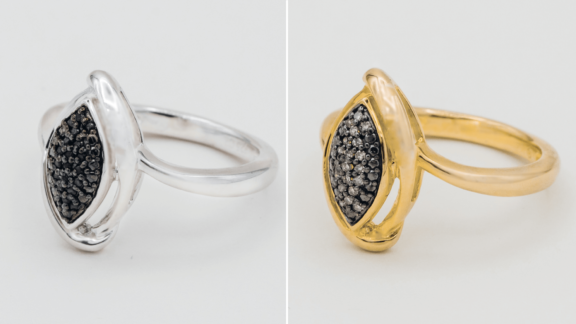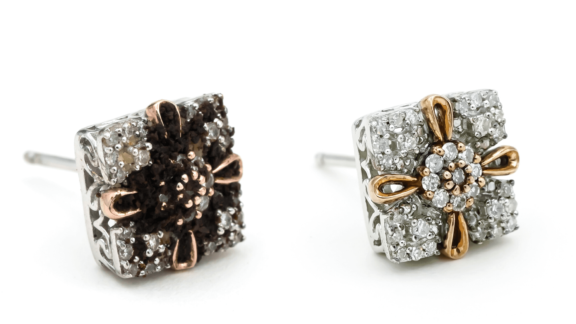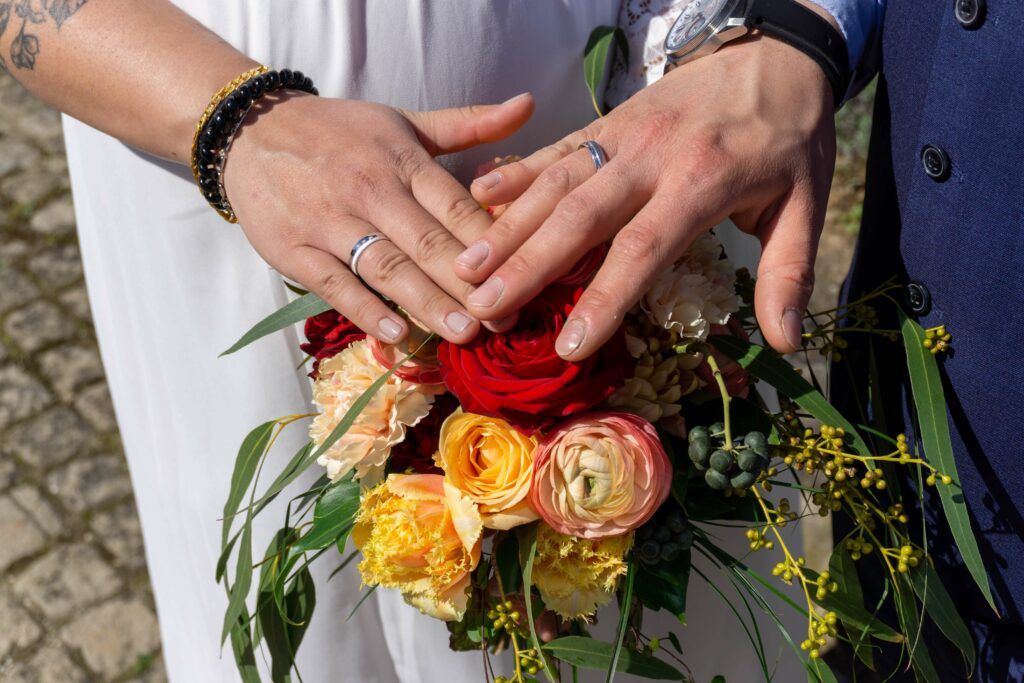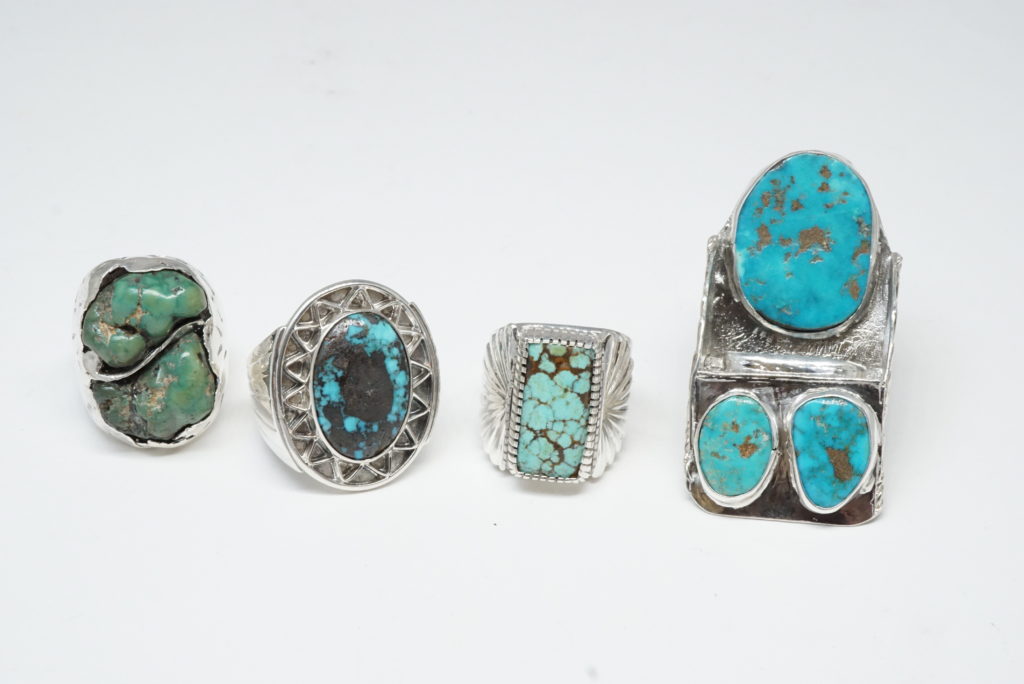How To Clean Tarnished Jewelry
Written by Annabelle
September 9, 2019

You're digging through your jewelry box and you see a beautiful piece you haven't worn in sometime. Gleefully pulling it out from the back of your jewelry box, your smile turns to a frown as you realize it's now a dull, splotchy color after months of not wearing it. How do you restore it back to its original condition? Read on to learn how to clean tarnished jewelry.
Tarnishing – What Is It?
When jewelry changes color, it's actually the result of a chemical reaction. On a daily basis, your jewelry is in contact with the oils and sweat from your body, as well as the various chemicals in the air. The metal of your jewelry will be affected over time after long-term exposure to these chemicals, and the surface will begin to form compounds that change the color of the metal.
You might be thinking- wait, isn't gold resistant to tarnish? That's definitely true, but commercial gold is very rarely pure gold. Gold in its natural state is very soft, and in order to create strong jewelry suitable for daily wear manufacturers combine gold with other metals such as copper, silver, or palladium to strengthen the metal. These combinations are called alloys, and are graded by the actual percentage of gold. That's why gold jewelry is referred to as 10k, 14k, or 18k; when divided by 24, these number reveal how much gold is in your jewelry. It isn't the gold in the alloy that's tarnishing- it's the slight oxidation of the other metals in the alloy that may be changing the color of your jewelry.
Many metals naturally tarnish. Copper, brass, bronze, and silver will eventually darken and change color over time if not cleaned on a regular basis. And plated jewelry will eventually tarnish as well, as the oxidation of the base metal will seep through the gold plating. It's important to understand how these metals work in order to know how to clean tarnished jewelry.
The Different Types of Tarnishing
To properly go about cleaning tarnished jewelry, you'll need to understand what's going on with your piece. There are three different scenarios for tarnishing:
-
- The jewelry is tarnish-prone: Base metals, such as copper, brass, and bronze will tarnish by default. Silver, despite being a precious metal, will also oxide and darken over time.
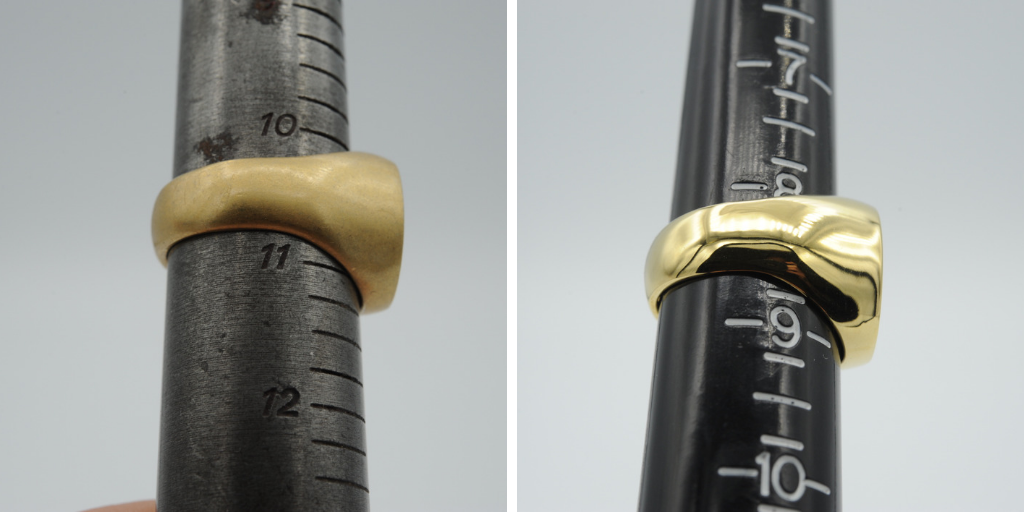
A brass ring before and after polishing.
- The jewelry is made from a gold alloy: A little bit of discoloration will occur over time, most commonly seen in antique pieces.
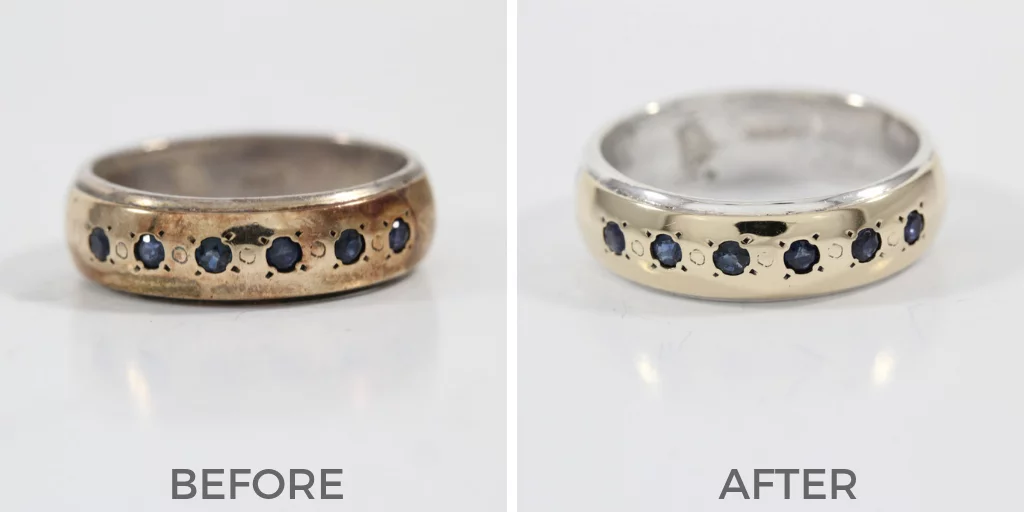
This gold ring came in badly oxidized and left after a good polish.
- The jewelry is plated: A combination of oxidation and daily wear has caused the plating to come off, and the tarnished metal underneath is diffusing through the plating to darken the jewelry. This happens with costume jewelry quite often.
- Gold-plated jewelry: While gold doesn't tarnish, the base metal underneath the gold plating will definitely oxidize over time. This oxidation seeps through the gold plating, darkening your jewelry. To fix this, the jeweler has to polish the entire piece, removing the original gold plating. Once the surface has been properly prepared, the jeweler then moves it into a gold-plating tank, where electricity fuses gold particles to the surface of the item.
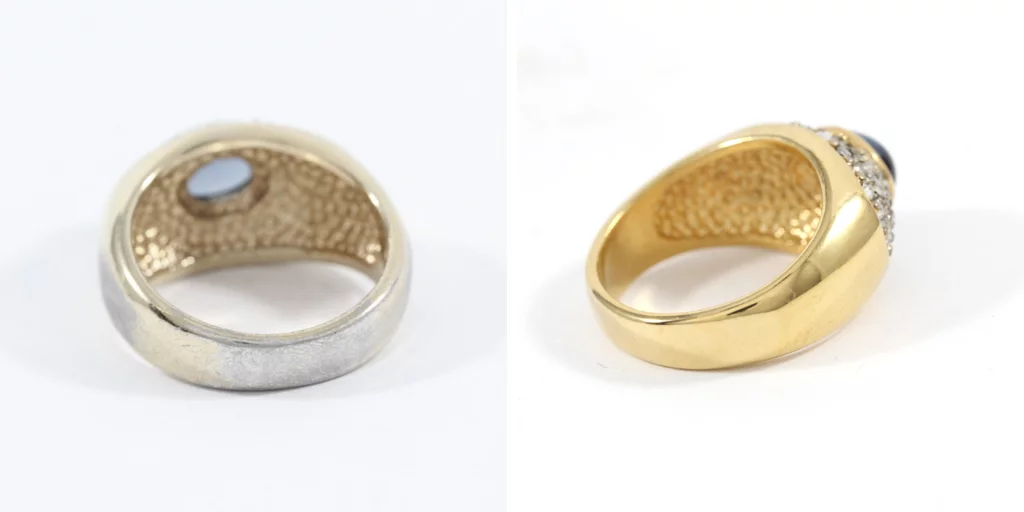
This ring was plated with 18k yellow gold
- Gold-filled jewelry: Gold-filled jewelry is a little different to work with than gold-plated jewelry. The difference between the two lies in its construction- gold-plated jewelry is a thin layer of gold over a base metal. Gold-filled jewelry is a thicker sheet of gold fused to the top of a base metal. As such, gold-filled jewelry can be restored via the same method of polishing and replating, but its color will look brighter than the original piece.
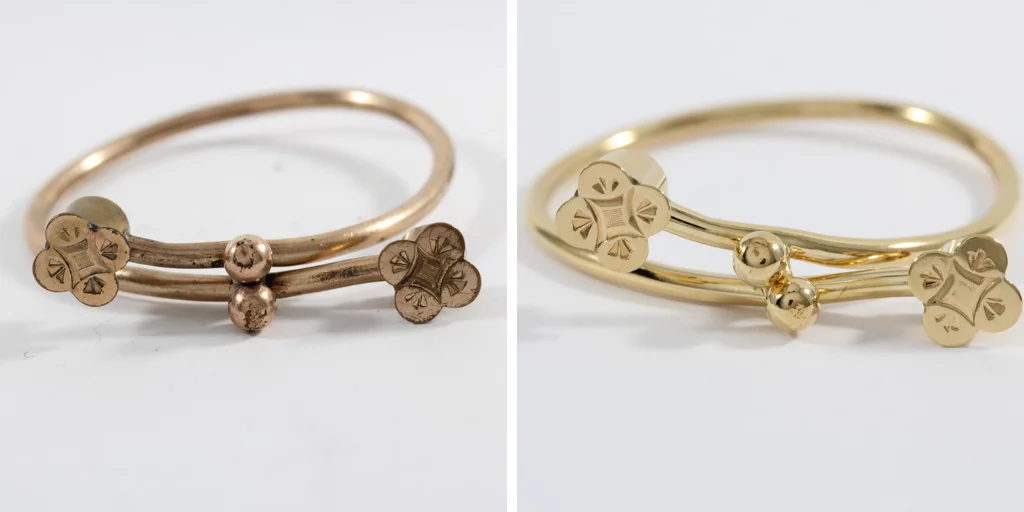
Note the difference in this gold-filled bracelet before and after plating.
- Gold-plated jewelry: While gold doesn't tarnish, the base metal underneath the gold plating will definitely oxidize over time. This oxidation seeps through the gold plating, darkening your jewelry. To fix this, the jeweler has to polish the entire piece, removing the original gold plating. Once the surface has been properly prepared, the jeweler then moves it into a gold-plating tank, where electricity fuses gold particles to the surface of the item.
- The jewelry is tarnish-prone: Base metals, such as copper, brass, and bronze will tarnish by default. Silver, despite being a precious metal, will also oxide and darken over time.
-
-
- White gold also deserves a mention here: this alloy doesn't exactly tarnish. However, owners of white gold jewelry may be confused as to why their piece suddenly went from a bright silvery color to a yellowish-white. This is most likely due to the loss of rhodium plating, an industry-standard treatment for white gold jewelry that enhances its appearance. The alloy itself is by default an off-white color; the rhodium that's applied on top gives it that characteristic white look, and once the plating wears off you'll see the metal underneath. A jeweler can polish the piece and re-plate it with rhodium to restore its look.
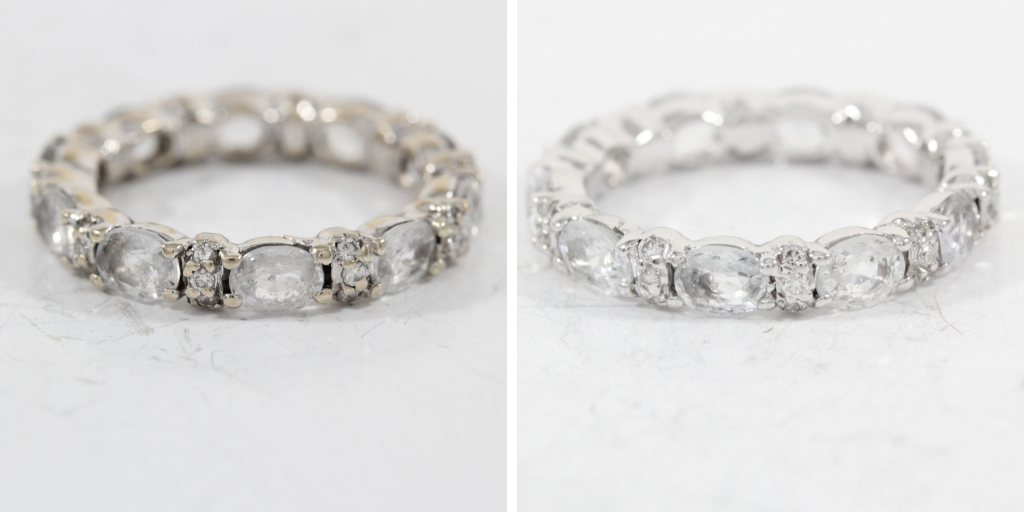
This white gold ring was yellowish due to missing rhodium plating.
- White gold also deserves a mention here: this alloy doesn't exactly tarnish. However, owners of white gold jewelry may be confused as to why their piece suddenly went from a bright silvery color to a yellowish-white. This is most likely due to the loss of rhodium plating, an industry-standard treatment for white gold jewelry that enhances its appearance. The alloy itself is by default an off-white color; the rhodium that's applied on top gives it that characteristic white look, and once the plating wears off you'll see the metal underneath. A jeweler can polish the piece and re-plate it with rhodium to restore its look.
-
Solutions for How to Clean Tarnished Jewelry
First, assess your piece; if you know what the metal is, that's a good start. Plated items are pretty easy to identify- you'll see the base metal showing underneath areas where the plating has worn away. If you're unsure, check your item for metal stamps such as 14k, or 925. Copper, brass, and bronze jewelry are rarely stamped, and they're fairly distinctive in terms of color.
Once you've figured out your jewelry, you can then proceed with the correct cleaning method.
- Polishing: For gold, sterling silver, and brass, you can simply take the item to a jeweler and get it lightly buffed. This will remove the tarnishing from the surface and reveal the true metal color underneath.
- Plating: If you're attempting to clean costume jewelry with no success, you'll probably need to get it re-plated because the color won't restore itself no matter how much you clean. The jeweler will polish the item and place it in a gold plating tank to reattach a coating of gold onto your jewelry.
- Steam and Ultrasonic Cleaning: Once the jeweler's done with polishing and plating, the item is submerged in a tank that blasts the jewelry with bubbles. The bubbles remove dirt trapped behind prongs and other hard-to-clean areas. As a finishing touch, it'll also go under a nozzle of high-concentrated steam to ensure that the jewelry is pristine.
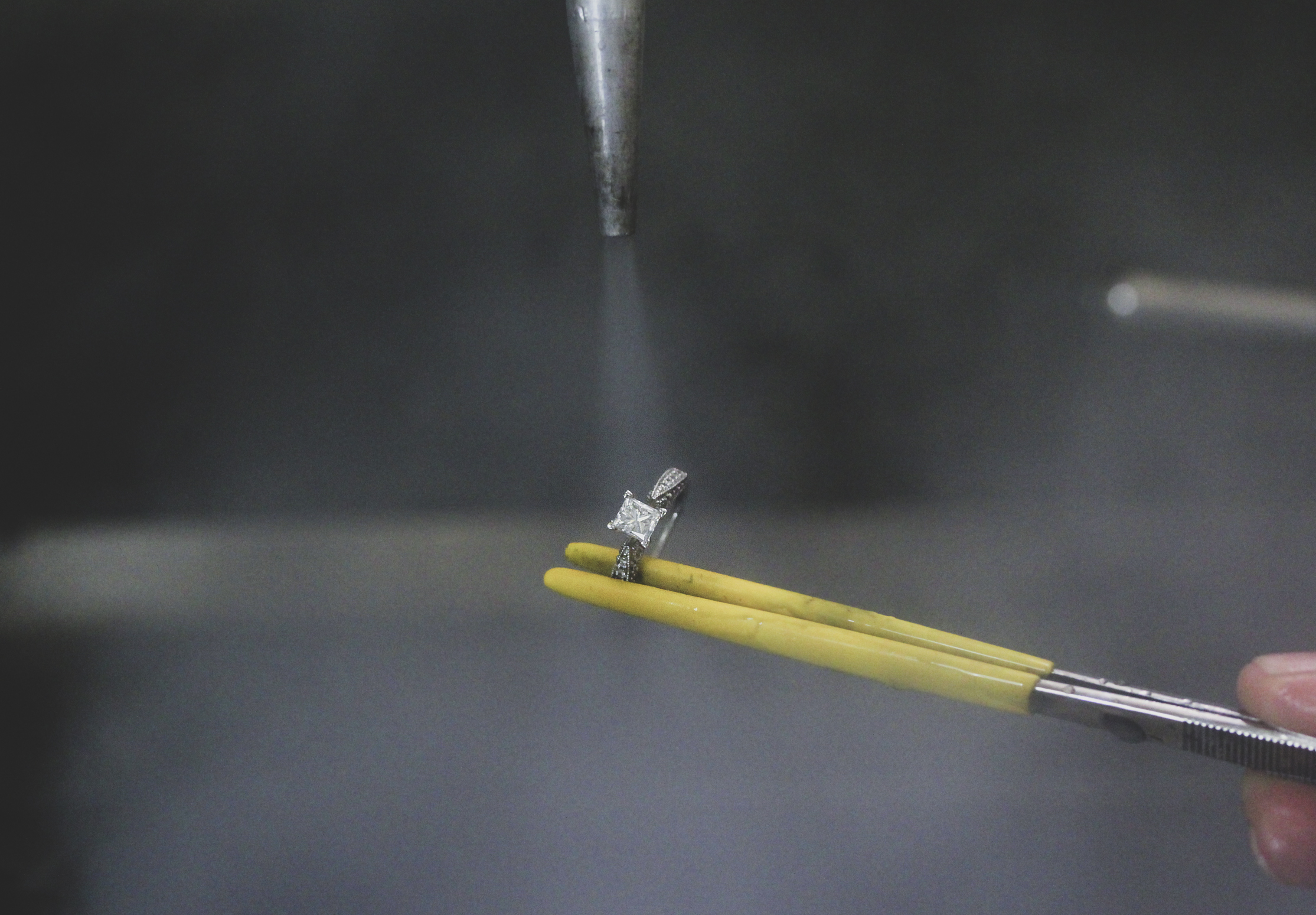
A ring being steam cleaned
While there are a variety of methods to clean tarnished jewelry at home, we actually don't recommend it! Here's why:
- The chemicals are too harsh: It's a common trick to use toothpaste to clean tarnished sterling silver at home. However, toothpaste is actually really strong and can scratch the surface of your jewelry while taking off the tarnish. Other household cleaners may also be too much for your jewelry to handle- anything that contains bleach or chlorine will actually eat away at gold!
- The method is ineffective: Polishing cloths slightly work, but they can't remove deep scratches, dents, or pitting. In addition, it's not a solution for cleaning every type of metal, and it won't restore plated jewelry.
- The water will loosen stones: Costume jewelry stones are often glued on. When you try cleaning pieces at home with warm water, that will remove the glue, causing the stones to fall out.

This Jesus pendant has a missing rhinestone.
How to prevent jewelry from tarnishing
Now that you know how to clean tarnished jewelry, here are some tips on how to prevent your jewelry from turning color quickly.
- Clean your jewelry: The oils and sweat on your skin accumulate on your jewelry throughout the day. To prevent tarnishing, wipe it down with a soft cloth and store it in a padded area every night before you go to bed.
- Avoid working out, swimming, showering, and cooking with jewelry on: Before you do any of those activities, just take your jewelry off. The sweat and the chemicals negatively affects your metal and will destroy any plating much faster.
- Get it treated: For base metals such as copper, you can buy a sealant online that will act as an anti-tarnish coating. Keep in mind that if you bring your item in for polishing at the jeweler's you'll have to reapply the sealant, as the process will remove the coating.
Now you should be aware of how to clean tarnished jewelry! If you're looking for a professional touch, send us your whole batch for our jewelry spa bundle, which includes polishing, cleaning, and stone tightening!
